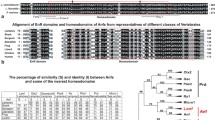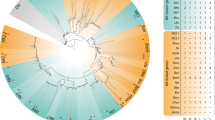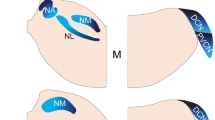Abstract
Nkx5 family members are homeobox transcription factors important for sensory organ development. Several members of the Nkx5 family are expressed in the eye, brain, developing ear, and lateral line. Members of this family have been previously identified in medaka, chick, and mouse. Here, we characterize two members of the Nkx5 family, Nkx5.3 and SOHo, in Xenopus laevis. We verify the identity of X. laevis Nkx5.3 and SOHo by phylogenetic comparison to chicken, medaka, and zebrafish orthologs. Both Nkx5.3 and SOHo are expressed in the developing eye, ear, lateral line system, and cranial neurons as determined by in situ hybridization.



Similar content being viewed by others
References
Adamska M, Wolff A, Kreusler M, Wittbrodt J, Braun T, Bober E (2001) Five Nkx5 genes show differential expression patterns in anlagen of sensory organs in medaka: insight into the evolution of the gene family. Dev Genes Evol 211(7):338–349
Deitcher DL, Fekete DM, Cepko CL (1994) Asymmetric expression of a novel homeobox gene in vertebrate sensory organs. J Neurosci 14(2):486–498
Mitton KP, Swain PK, Chen S, Xu S, Zack DJ, Swaroop A (2000) The leucine zipper of NRL interacts with the CRX homeodomain. A possible mechanism of transcriptional synergy in rhodopsin regulation. J Biol Chem 275(38):29794–29799
Nieuwkoop PD, Faber J (1994) Normal table of Xenopus laevis (Daudin). Garland Publishing, Inc., New York
Perron M, Kanekar S, Vetter ML, Harris WA (1998) The genetic sequence of retinal development in the ciliary margin of the Xenopus eye. Dev Biol 199(2):185–200
Saha MS, Michel RB, Gulding KM, Grainger RM (1993) A Xenopus homebox gene defines dorsal-ventral domains in the developing brain. Development 118(1):193–202
Schlosser G (2014) Early embryonic specification of vertebrate cranial placodes. Wiley Interdiscip Rev Dev Biol 3(5):349–363
Schorderet DF, Nichini O, Boisset G, Polok B, Tiab L, Mayeur H, Raji B, de la Houssaye G, Abitbol MM, Munier FL (2008) Mutation in the human homeobox gene NKX5-3 causes an oculo-auricular syndrome. Am J Hum Genet 82(5):1178–1184
Sive HL, Grainger RM, Harland RM (2000) Early development of Xenopus laevis: a laboratory manual. Cold Spring Harbor Laboratory Press, Cold Spring Harbor
Stadler HS, Solursh M (1994) Characterization of the homeobox-containing gene GH6 identifies novel regions of homeobox gene expression in the developing chick embryo. Dev Biol 161(1):251–262
Viczian AS, Vignali R, Zuber ME, Barsacchi G, Harris WA (2003) XOtx5b and XOtx2 regulate photoreceptor and bipolar fates in the Xenopus retina. Development 130(7):1281–1294
Wang W, Lo P, Frasch M, Lufkin T (2000) Hmx: an evolutionary conserved homeobox gene family expressed in the developing nervous system in mice and Drosophila. Mech Dev 99(1–2):123–137
Whitaker SL, Knox BE (2004) Conserved transcriptional activators of the Xenopus rhodopsin gene. J Biol Chem 279(47):49010–49018
Acknowledgments
We thank Barry Knox for the kind gift of Nkx5.3 cDNA. We thank A. Rorick and K. Fannin for persistent attempts at isolation of SOHo cDNA. This work was supported by National Institutes of Health grant EY015480 to HME.
Author information
Authors and Affiliations
Corresponding author
Additional information
Communicated by Matthias Hammerschmidt
Rights and permissions
About this article
Cite this article
Kelly, L.E., El-Hodiri, H.M. Xenopus laevis Nkx5.3 and sensory organ homeobox (SOHo) are expressed in developing sensory organs and ganglia of the head and anterior trunk. Dev Genes Evol 226, 423–428 (2016). https://doi.org/10.1007/s00427-016-0555-2
Received:
Accepted:
Published:
Issue Date:
DOI: https://doi.org/10.1007/s00427-016-0555-2




